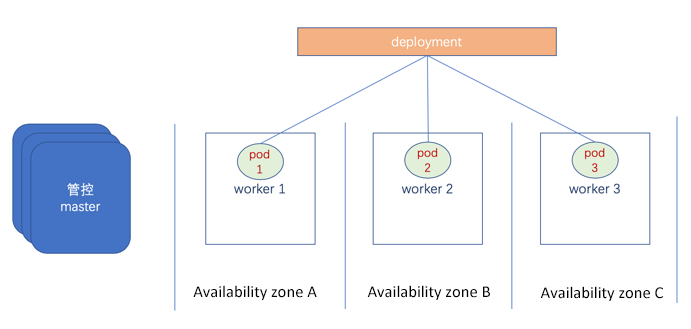By Zhu Yansheng
Currently, the worker nodes in Kubernetes clusters support ECS in multiple availability zones. The deployment mode is to make it possible to distribute multiple (two at least) Pods of one application in several different availability zones (at least not in the same availability zone) to implement high availability or local backup for disaster recovery.

To achieve the aforementioned desired effect, Kubernetes provides pod affinity and anti-affinity to ensure high availability deployment of pods at the node level and availability-zone level. The specific value is topologyKey: failure-domain.beta.kubernetes.io/zone.
After a cluster is created on the ACK, each node added from any availability zone will be marked with that availability zone label. For example, a node in Beijing zone A, if added to the Kubernetes cluster, will have a label like this: failure-domain.beta.kubernetes.io/zone: cn-beijing-a.
With this label, we can use the yaml file to assign Pods to different availability zones when we deploy an application in multiple availability zones.
Example yaml file:
apiVersion: apps/v1
kind: Deployment
metadata:
name: redis-cache
spec:
selector:
matchLabels:
app: store
replicas: 3
template:
metadata:
labels:
app: store
spec:
affinity:
podAntiAffinity:
preferredDuringSchedulingIgnoredDuringExecution:
- labelSelector:
matchExpressions:
- key: app
operator: In
values:
- store
topologyKey: "failure-domain.beta.kubernetes.io/zone"
containers:
- name: redis-server
image: redis:3.2-alpineThe "podAntiAffinity:" in this yaml file specifies node anti-affinity. In addition, because topologyKey: "failure-domain.beta.kubernetes.io/zone" is used, if the "failure-domain.beta.kubernetes.io/zone" key has three values (for example, cn-beijing-a, cn-beijing-b, andcn-beijing-c), Pods will be assigned to these three availability zones. preferredDuringSchedulingIgnoredDuringExecution allows pods to be assigned to different availability zones as far as possible if the number of Pods is greater than that of availability zones. Remaining extra pods will be assigned to the availability zone where the original Pods are.
Many other methods are available, including deployment at the node level. For more information, visit https://kubernetes.io/docs/concepts/configuration/assign-pod-node/#affinity-and-anti-affinity
Because disks cannot be mounted across availability zones, if a Pod uses volume, that Pod should be scheduled to a machine in the same availability zone as the volume.
Other volumes like NAS and OSS can use the preceding deployment method.
Best Practices of Log Analysis and Monitoring by Using Kubernetes Ingress

182 posts | 32 followers
FollowAlibaba Container Service - November 21, 2024
Alibaba Cloud Native - March 28, 2024
Alibaba Clouder - July 15, 2020
Aliware - July 3, 2020
Apache Flink Community China - September 16, 2020
Alibaba Container Service - March 12, 2024

182 posts | 32 followers
Follow Container Service for Kubernetes
Container Service for Kubernetes
Alibaba Cloud Container Service for Kubernetes is a fully managed cloud container management service that supports native Kubernetes and integrates with other Alibaba Cloud products.
Learn More ACK One
ACK One
Provides a control plane to allow users to manage Kubernetes clusters that run based on different infrastructure resources
Learn More Database Security Solutions
Database Security Solutions
Protect, backup, and restore your data assets on the cloud with Alibaba Cloud database services.
Learn More Backup and Archive Solution
Backup and Archive Solution
Alibaba Cloud provides products and services to help you properly plan and execute data backup, massive data archiving, and storage-level disaster recovery.
Learn MoreMore Posts by Alibaba Container Service
Start building with 50+ products and up to 12 months usage for Elastic Compute Service
Get Started for Free Get Started for Free